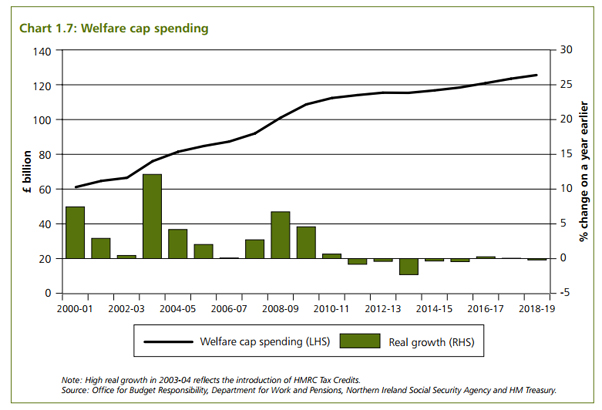“The last government said they were controlling welfare and it ballooned by 70 per cent, but the public were told constantly it was under control…”
– Iain Duncan Smith, work and pensions secretary, BBC Radio 4, 26 March 2014
The background
It’s a familiar refrain from the current government: Labour allowed welfare spending to spin out of control.
Last week, George Osborne said welfare spending should “never again” be allowed to “spiral out of control”.
Yesterday morning, Iain Duncan Smith echoed the chancellor, saying that welfare spending “ballooned” under Labour.
This, the government claims, is the justification for the welfare cap MPs voted on in the House of Commons yesterday.
We’ve already looked at the bones of the welfare cap, but in essence, it’s an annual cap on spending for certain elements of welfare spending.
But is Mr Duncan Smith justified with his justification?
The analysis
When we asked the Department for Work and Pensions how Mr Duncan Smith had worked out his 70 per cent figure, they replied: “Excluding pensions and JSA [Jobseekers’ Allowance], welfare spending [went] up from £70bn in 1997 to £118bn in 2010 – 70% or £48bn real increase.”
This was based on figures from the Autumn 2013 forecasts, and at 2013/14 prices.
In 1997/98, total spending, in real terms, on benefits and tax credits was £125bn. That had gone up to £199.7bn by 2010/11 – an increase of 60 per cent.
But, much of this spending won’t be included within the welfare cap.
According to the Treasury, the following will be excluded from the welfare cap (see p88):
– Jobseekers’ Allowance (JSA) and additional housing benefit
– State pensions
– Universal Credit payments to claimants on zero incomes
– Council tax benefits
– TV licences for over-75s
– Sure Start Maternity Grants, Funeral Expense Payments, New Deal and employment programme allowances, New Enterprise Allowance, specialised vehicles fund and vaccine damage payments
– War pensions
So, if we take these away from welfare spending to match the cap, under Labour, in real terms, it went from £69.7bn in 1997/8 to £120bn. An increase of 72 per cent. So Mr Duncan Smith is correct.
But only up to a point.
Last week, when he unveiled the budget, Mr Osborne included some figures on welfare spending – both within and outwith the cap – and they don’t seem to match what the DWP says (see the graph below).
Admittedly, they only go from 2000, so don’t include the first three years of the Labour government.
When their figures are adjusted for inflation, according to numbers crunched by the IFS via the GDP deflator, in 2000, welfare spending under the cap was £83.8bn; by 2010/11, it was £119.9bn – a rise of 43 per cent.
Of course we haven’t included the first three years, so overall spending in real terms will have increased by some degree. But it’s unlikely that spending in 1997-2000 would be as much as 27 per cent and reach the 70 per cent figure Mr Duncan Smith was talking about.
So why the discrepancy?
A footnote with the DWP’s figures – on which Mr Duncan Smith’s claim is based – partly explains why: “Figures quoted are estimates because at Autumn Statement 2013 the Welfare Cap definition and housing benefit unemployed expenditure were not available.
“Calculations are therefore based on the best available information.”
By the time of the budget, the Treasury had worked out what would be within the cap.
Hence, the cost of things such as war pensions or council tax benefits weren’t included in Mr Duncan Smith’s figures.
The figures will also have changed slightly due to adjustments for inflation and so on, but the six months or so between the two sets won’t make that big a difference.
The verdict
There is no denying that spending on welfare under Labour went up.
As Carl Emmerson, deputy director of the IFS points out: “It went up under a period of growth, until about 2007 or so, and due to deliberate policy decisions to help people on low incomes.”
What’s slightly more worrying is that Mr Duncan Smith is one of the biggest proponents of the cap, but appears on the airwaves using out-of-date figures.
The DWP concedes the numbers he uses were based on latest available estimates, but there’s little excuse not to use latest Treasury figures, given the budget was only a week or so ago.
Mr Duncan Smith may have a point in saying Labour’s spending was out of control, but he’d be wiser to check his facts first.





